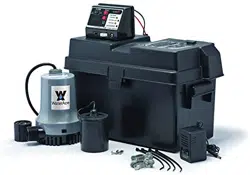Loading ...
Loading ...

Provide proper ventilation. The battery enclo-
sures should be designed to prevent accumu-
lation and concentration by hydrogen gas in
“pockets” at the top of the compartment. Vent
the battery compartment from the highest point.
Aslopedlidcanalsobeusedtodirecttheow
to the vent opening location. To reduce the risk
of the battery explosion, follow all the instruc-
tions of the battery supplier or any equipment
you intend to use in the vicinity of batteries.
Use the correct insulated
tools to make AC/DC
wiring connections.
Do not install battery/controls
onornearammablemateri-
als (plywood, chemicals, gas online etc.)
Personal Precautions:
Someone should be within
the range of your voice to
come to your aid when you work near batteries.
Have plenty of fresh water
and soap nearby in the event
that battery acid contact skin, clothing or eyes.
Wear complete eye and
clothing protection.
Avoid touching eyes while
working near batteries. Wash
your hands when done.
If battery acid comes in
contact with skin or clothing,
wash immediately with soap and water.
KNOWING YOUR SYSTEM
The battery pack acts as a reserve to ensure
continuous supply of power whenever mains
supply from utility power is not available. The
controls are used to charge the batteries when
normal utility power is available and converts the
battery’s DC to AC voltage to run the pump when
utility power is lost.
BATTERY SAFETY
A battery can present a risk of severe burn and
injury from high short circuit current. The follow-
ing precautions should be observed when work-
ing on batteries.
1.Donotdisposeofbatteryinare.Thebattery
may explode.
3
2. Do not open or mutilate the battery. Released
electrolyte is harmful to the skin and eyes. It
may be toxic.
3. The electrolyte is a dilute sulfuric acid that is
harmful to the skin and eyes. It is electrically
conductive and corrosive. The following
procedures should be observed:
a.Ifelectrolytecontactstheskin,washito
immediately.
b.Ifelectrolytecontactstheeyes,ush
thoroughly and immediately with water. Seek
medical attention.
c. Spilled electrolyte should be washed down
with a suitable acid neutralizing agent. A
common practice is to use a solution of
approximately one pound (500 grams)
bicarbonate of soda to approximately one
gallon (4 liters) of water. The bicarbonate
of soda solution be added until the evidence
of reaction (foaming) has ceased. The result
ingliquidshouldbeushedwithwaterand
the area dried.
4. Do not reverse the battery connections, as it
will blow the battery fuse. A power cord has
been provided to connect the controls to an
incoming AC wall outlet.
BATTERY REQUIREMENTS
Your unit operates on 12VDC battery power
when in the power fail mode. A UL recognized
deep cycle marine battery should be used. There
are two principal types of batteries: starting and
deepcycle.Thereareseveraldierenttypesof
battery constitutions including liquid lead acid,
nickel iron, nickel cadmium, alkaline and mainte-
nance free. Batteries can be sealed or vented.
Starting Batteries
Starting batteries are designed for high crank-
ing power but not deep cycling. Do not use them
with your back-up sump pump. They will simply
not last long in a deep cycle application.
Deep Cycle Batteries
Deep cycle batteries are best suited for use with
the battery back-up sump pump. They are de-
signed to have the majority of their capacity used
before recharge. Available in many sizes and
types, be sure to use at least a 80AH battery.
BATTERIES NOT INCLUDED
Loading ...
Loading ...
Loading ...
